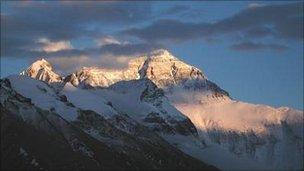Everest pioneers 'hit by storm'
- Published

Mallory and Irvine were attempting to reach Everest's summit for the first time
An extreme storm may have contributed to the deaths of famed climbers George Mallory and Andrew Irvine as they tried to reach Everest's summit in 1924.
That is the conclusion of a new study using weather data recorded during their historic expedition.
Mallory and Irvine were sighted on 8 June 1924, scaling Everest's north-east ridge, before vanishing.
The storm caused a pressure drop big enough to deprive the climbers of oxygen, the new study proposes.
The research, published in the journal Weather, focuses on meteorological measurements from the 1924 expedition, which the authors uncovered at the Royal Geographical Society library in London.
Although the data were published as a table in a 1926 report on the expedition, they were never analysed for information on the disappearance of Mallory and Irvine until this study.
The researchers analysed barometric pressure measurements and found that during the Mallory and Irvine summit attempt, there was a pressure drop at Everest base camp of approximately 18 millibars (mbar).
Lead author GW Kent Moore, from the University of Toronto, Canada, described this as "quite a large drop".
He said: "We concluded that Mallory and Irvine most likely encountered a very intense storm as they made their way towards the summit."
The finding is potentially controversial, because a debate still rages over whether the climbers reached Everest's summit before vanishing on its slopes.
Professor Moore told BBC News: "I think it is fair to say that the existence of the storm would have greatly complicated Mallory and Irvine's summit attempt."
Dr John Semple, chief of surgery at the Women's College Hospital in Toronto, said: "Mount Everest is so high that there is barely enough oxygen near its summit to sustain life and a drop of pressure of four mbar at the summit is sufficient to drive individuals into a hypoxic state."
The authors of the study propose that the pressure drop and ensuing hypoxia contributed to the climbers' deaths, together with existing stresses such as the extreme cold, high winds and the uncertainty over their route to the summit.
Mountaineer Noel Odell was climbing behind Mallory and Irvine and was the last person to see them alive as they disappeared from view on the mountain's north-east ridge.
Odell claimed that a blizzard had occurred on the afternoon that the climbers disappeared. But many writers ignored this, as Odell believed that it had lasted only for a short period of time.
Mallory's body was discovered in 1999, but this has not yielded any clues to whether the summit was reached.
It would take until 1953 for climbers to reach the summit of Everest and return to tell the tale.
New Zealander Sir Edmund Hillary and Sherpa mountaineer Tenzing Norgay scaled the peak on 29 May as part of the ninth British expedition to the Himalayan mountain.